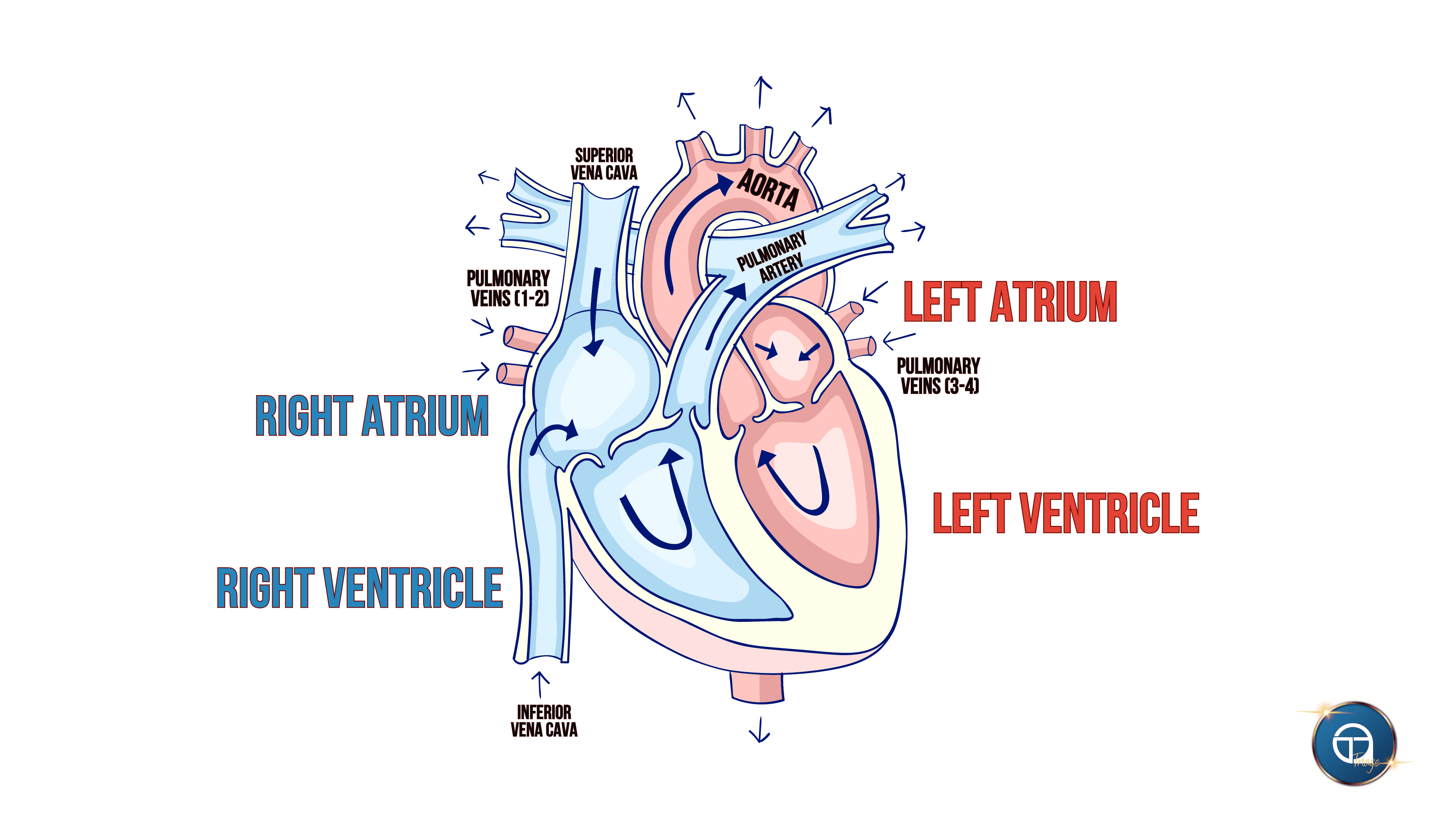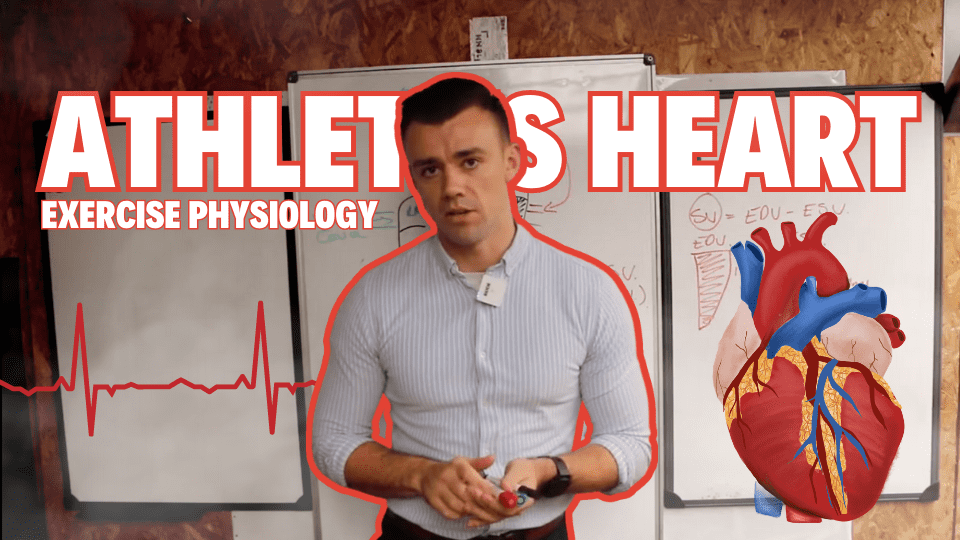There are specific heart adaptations to exercise, and these are very often poorly understood. So, in this article, I am going to be discussing these heart adaptations and what they mean for you. I’m going to be discussing the heart with an emphasis on exercise, and in particular, what we’re going to discuss are some of the adaptations that lend themselves to better cardiac function and thus better exercise performance in response to training. That then leads us to a discussion of some of the differences between the untrained and the trained individual when it comes to their cardiac function, but we will get stuck into all of that in a moment. To discuss all of this, we do actually have to discuss some foundational physiology, so let’s get stuck into it!
Heart Adaptations To Exercise
The heart plays a crucial role in exercise by delivering oxygenated blood to working muscles and vital organs while efficiently removing waste products like carbon dioxide. As exercise intensity increases, the heart’s ability to perform its functions becomes even more critical. In this article, we’ll explore the cardiac function and its impact on exercise performance.
Cardiac Anatomy and Function
The heart is divided into four chambers: left atrium, left ventricle, right atrium, and right ventricle. The left ventricle, responsible for pumping oxygenated blood to the body, is particularly muscular due to its workload. The right side of the heart deals with deoxygenated blood, sending it to the lungs for oxygenation. Valves such as the mitral valve (between left atrium and ventricle) and tricuspid valve (between right atrium and ventricle) regulate blood flow.

Maximising Cardiac Output: Stroke Volume and Heart Rate
Cardiac output (CO) is the amount of blood pumped by the heart in a minute and is calculated as the product of heart rate and stroke volume. Heart rate represents beats per minute, while stroke volume is the blood volume ejected with each heartbeat.
Stroke Volume Determinants
Stroke volume is influenced by end-diastolic volume (blood in the chamber before contraction) and end-systolic volume (remaining blood after contraction). Efficient contraction allows for a larger difference between these volumes, leading to a higher stroke volume. However, we also need a large end-diastolic volume (greater filling of the heart), as without this, a large ejection fraction (efficiency of contraction, assessed by ESV/EDV) is insufficient for a large stroke volume. Better filling + contraction = greater stroke volume = more blood pumped around the body per beat.
Optimising Cardiac Output
Efficient exercise performance requires maximising both heart rate and stroke volume. Athletes achieve this by increasing venous return, enhancing the heart’s ability to relax and contract, and maintaining muscle function. Hormones and the nervous system also play roles in these processes. In the untrained, a high heart rate will compromise stroke volume sooner than for an athlete, and therefore, it is both the ability to pump fast and efficiently that permits the athlete to maintain a large cardiac output.
Overcoming Challenges
Challenges to optimal cardiac output include conditions like aortic stenosis, where a narrowed aortic valve restricts blood flow. Athletes, through training, improve their heart’s ability to handle greater cardiac demands while maintaining stroke volume, leading to higher cardiac output. Interestingly, in patients with aortic stenosis, you also see thickening of the heart due to this resistance, but this is an example of pathological vs physiological adaptation. Similarly, in various cardiomyopathies, the heart can be large, muscular, but of poor quality (e.g. fibrous tissue in the heart muscle), compromising its function. Therefore, we can’t simply think of “heart thickness” as being inherently good or bad. Context matters.
Conclusion: Athlete’s Advantage
In summary, trained athletes can sustain higher heart rates without compromising stroke volume compared to untrained individuals. This advantage is attributed to optimised blood return, efficient relaxation and contraction of the heart, and overall cardiovascular fitness. Future content will delve deeper into these topics and provide practical insights for training.
If you are interested in improving your own training, then we do offer comprehensive online coaching. If you are interested in learning more about health and fitness, we do have a lot of free content on our free content page, and you can subscribe to our YouTube channel too. If you would like to calculate your max heart rate and heart rate zones, we do have a calculator on site that you can use.
FAQs
What are heart adaptations to exercise?
In response to the stress of exercise, the heart exhibits structural, electrophysiological, haemodynamic, and functional adaptations. The purpose of these adaptations is to enable the heart to pump out more blood per beat, thus making it work more efficiently. This is permissive of greater exercise performance, with some variance based on the type of exercise (e.g. resistance vs endurance).
What specific adaptations does the heart undergo due to exercise?
Well-trained athletes generally have larger hearts that pump more efficiently, and beat less (lower resting heart rate) at rest. However, they can also beat very quickly (high max heart rate) without losing efficiency, which is a core component of maximising cardiac output (cardiac output = stroke volume x heart rate). The heart’s stroke volume increases by improving filling (diastole) and emptying (systole), enabling more blood to be pumped out per beat. It’s not just about muscular adaptations, but also electrophysiological (e.g. increased parasympathetic/vagal tone), vascular (e.g. coronary artery dilation), and more.
How does exercise impact heart rate?
As mentioned above, exercise tends to reduce resting heart rate via the structural/functional and electrophysiological adaptations. This is accompanied by higher heart rate variability (HRV), which reflects increased parasympathetic nervous system (vagus nerve) activity. Athletes may have resting heart rates in the 40s or even 30s without any ill effects, due to the efficiency of the heart’s pumping (requiring less beats to pump blood around the body). The thing that makes athletes special is that, not only do they have a low resting heart rate, they have a high max heart rate, reflecting a wide cardiovascular range. This enables high performance and is associated with great health outcomes.
Can exercise lead to an increase in heart size?
Yes, athletes generally have larger hearts, with some. variance depending on the type of exercise. The most dominant chamber, the left ventricle, is susceptible to significant adaptation (increased thickness and/or volume, depending on exercise mode), but so are the other chambers of the heart. The observation of such structural adaptations is often called “athlete’s heart”, and it’s actually a beneficial adaptation that allows the heart to pump more blood with each beat. While it is typically seen in endurance athletes, it can also be seen in those who primarily engage in resistance training. Resistance training can be thought of as being primarily a pressure-mediated challenge on the heart, leading to a concentric hypertrophy pattern. Endurance training can be thought of as being primarily a volume/flow-mediated challenge on the heart, leading to an eccentric hypertrophy pattern.
Does exercise help reduce the risk of heart disease?
Yep, regular exercise lowers the risk of heart disease by improving overall cardiovascular health, reducing blood pressure, (mildly) improving cholesterol profile, and promoting healthy blood vessel function. Exercise is one of the most potent tools available to not only reduce heart disease risk, but also increase quality and quantity of life. There are very few contraindications, and thus exercise should be a staple for all, even those with established heart disease (consult with your doctor for advice before commencing exercise).
How long does it take to see heart adaptations from exercise?
While some cardiovascular benefits can be noticed within a few weeks (or even days) of consistent exercise, more significant heart adaptations tend to take several months of regular training to be realised. The adaptation process is similar to that of building muscle, where you just have to be patient and do the right things, and eventually, the body will adapt appropriately.
What types of exercise are best for heart health?
Both cardiovascular exercise (both aerobic and anaerobic) and resistance training can positively impact heart health. A combination of both is often recommended for comprehensive cardiovascular benefits, although the vast majority of your time is likely to be spent doing aerobic cardiovascular training if you are trying to maximise the heart rate adaptations to exercise.
How much exercise is needed for heart adaptations?
We generally recommend at least 150 minutes of moderate-intensity aerobic activity or 75 minutes of vigorous-intensity aerobic activity per week, as per the general exercise guidelines for health, along with resistance training twice per week. However, while there does seem to be a point of diminishing returns with more and more exercise, you can actually still see continued adaptations with more exercise than this.
Are there any risks associated with intense exercise on heart health?
Some individuals with established heart disease or underlying conditions they may not be aware of can experience adverse effects from exercise. However, such adverse effects are very rare, and generally speaking, intense exercise is appropriate for most people. When commencing any exercise programme, the key is to start with a small dose and gradually titrate up. There may be some risks for extreme athletes, but the benefits seem to outweigh them if so, which we discuss in this article on whether or not you can be too fit.

Gary McGowan
Hey, I am Dr Gary McGowan, co-founder of Triage, qualified Doctor, Physiotherapist, and Coach.
Having graduated with first class honours in Physiotherapy (BSc) and Medicine (MB BCh BAO), I aim to blend medical science with a decade of coaching experience to help you maximise your performance, transform your body, and optimise your health.
I enjoy grappling, hiking, lifting, and other modes of physical training. When I’m not training, I like to read broadly, particularly philosophy, religion, and history. I love the natural world, particularly the mountains & lakes of my hometown Killarney, County Kerry.


